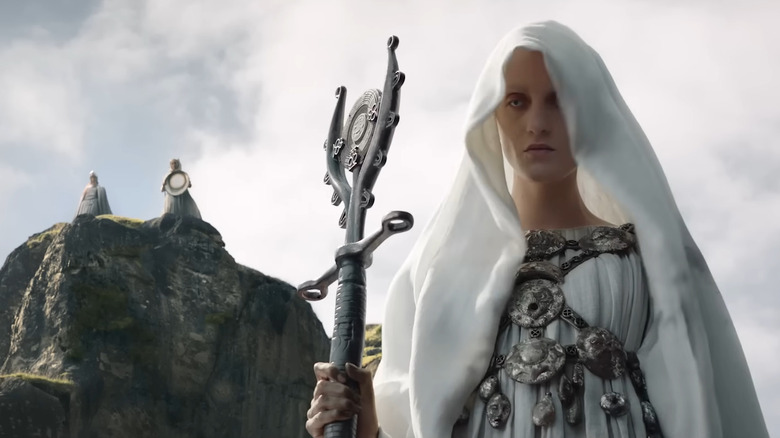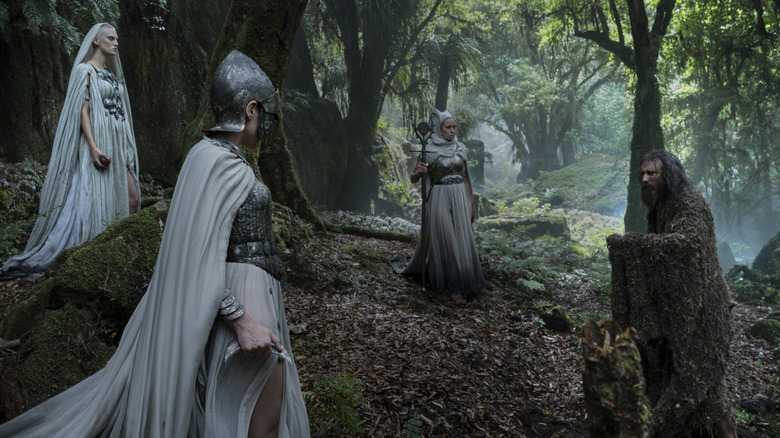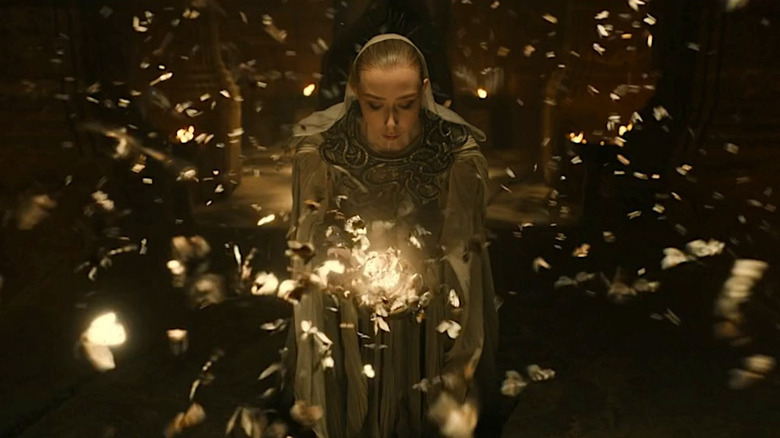Who Are The Three Witches In Rings Of Power?
One of the oddest elements of "The Rings of Power" Season 1 was the consistent presence of a trio of white-clad mystic women. They appear out of nowhere and proceed to hunt down The Stranger (Daniel Weyman). Initially, this is to recruit him to their master's cause, as they believe he is Sauron. When they discover he is a different, unnamed Istar (J.R.R. Tolkien's word for his unique order of uppercase "w" Wizards) on the Season 1 finale, and the Istar figures out that he is "good" and can fight back against his evil foes, their intentions turn hostile.
While the three witches were an interesting side plot during Season 1, they were back on Season 2, this time backed by a Dark Wizard. The question is, what are these magic-wielding female antagonists? Are they actual witches? You could kind of say that, but based on our research, Tolkien doesn't really use that term. Cult followers and acolytes are a better description based on what we know of these mystics. In "The Two Towers," Éomer uses the terms "net-weavers and sorcerers." What we know for sure is that they aren't Istari. Let's explore what magic-wielding individuals are called in Middle-earth and what description best fits the three witches on "The Rings of Power."
Wizards versus ordinary magic-wielders in Middle-earth
J.R.R. Tolkien goes to great pains to clarify that his Wizards are different from ordinary magic-wielders. In the book "Unfinished Tales," he explains that the Elvish word istar roughly translates as "wizard" or "wise," adding, "The translation [...] is not perhaps happy, since the Heren Istarion or 'Order of the Wizards' was quite distinct from the 'wizards' and 'magicians' of later legend."
The distinction here is important. If someone is a "Wizard" in Tolkien's world, they are one of five named Wizards (he technically didn't tell us how many Wizards there are in total). He describes this group in "Unfinished Tales" as "all Maiar, that is persons of the 'angelic' order, though not necessarily of the same rank. The Maiar were 'spirits,' but capable of self-incarnation, and could take 'humane' (especially Elvish) forms."
Why bring this up when we're talking about the three witches? Because their closest comparison point so far has been a good and a bad Wizard, and it's essential that we differentiate the two. The three white-clad acolytes are not "Wizards in training." They can never be the same as the Istari. However, it's possible for them to become powerful magic-wielders in their own ways (and some of them clearly already have that ability). This is because Tolkien leaves room in his world for less-than-angelic spiritual interactions with, well, the spiritual.
Mortal magic-wielders in Middle-earth
There are multiple instances where J.R.R. Tolkien references mortals engaging in magical and cult-like activity. For instance, the Mouth of Sauron (the creepy guy Aragorn beheads at the Black Gate of Mordor during the "Return of the King" movie), is described in the "Lord of the Rings" books as a renegade who "learned great sorcery, and knew much of the mind of Sauron." "The Silmarillion" describes the Ringwraiths as "kings, sorcerers, and warriors of old." The "Hobbit" book talks about Dwarves "putting a great many spells over [their treasure]."
One of the best cases for magic-wielding in Middle-earth comes in the story of the two Blue Wizards that Tolkien didn't talk about much. The role of these two power-wielding Istari shifted over time. Later in his life, Tolkien decided that they were heroic figures that played similar roles as Gandalf, just in the Eastern regions of Middle-earth.
However, earlier in his life, he favored the idea that, like Saruman, they had left the path of wisdom. In a letter in 1958 (via Laurelin Archives), he said, "I think they went as emissaries to distant regions, East and South, far out of Númenórean range: missionaries to 'enemy-occupied' lands, as it were." After this, he summarizes, "What success they had I do not know; but I fear that they failed, as Saruman did, though doubtless in different ways; and I suspect they were founders or beginners of secret cults and 'magic' traditions that outlasted the fall of Sauron."
Did you catch that? "Magic traditions" and "secret cults"? These are undoubtedly the foundation for the witch narrative on "The Rings of Power." Early on Season 2, we even see that they are able to use enchantments and ritual sacrifice to bring their fallen member back into their leader's presence. This isn't surprising, considering the fact that Sauron can extend the mortal lifespans of all nine Nazgûl for thousands of years. While Tolkien doesn't explicitly use the word "witch," now that we know more thanks to Season 2, we can definitively say that it's all semantics. Call them what you like. There's no doubt that the white-clad women are magic-wielding sorcerers, acolytes, and, dare we say, witches.


